Financial Management: Significance and Financial Performance
VerifiedAdded on 2023/06/18
|11
|2798
|123
Report
AI Summary
This report provides a detailed overview of financial management, emphasizing its significance in business operations. It covers key concepts such as financial planning, control, and decision-making, highlighting their importance in ensuring economic stability, safeguarding funds, and identifying investment opportunities. The report also examines essential financial statements, including the balance sheet, income statement, and cash flow statement, along with the application of financial ratios for assessing profitability, solvency, and liquidity. Furthermore, it discusses methods to improve financial performance, focusing on ratios like the quick ratio, gross profit ratio, working capital ratio, and current ratio, illustrating their role in evaluating and enhancing a company's financial health. The analysis underscores the critical role of effective financial management in achieving long-term sustainability and growth.

Importance of financial
management
management
Paraphrase This Document
Need a fresh take? Get an instant paraphrase of this document with our AI Paraphraser
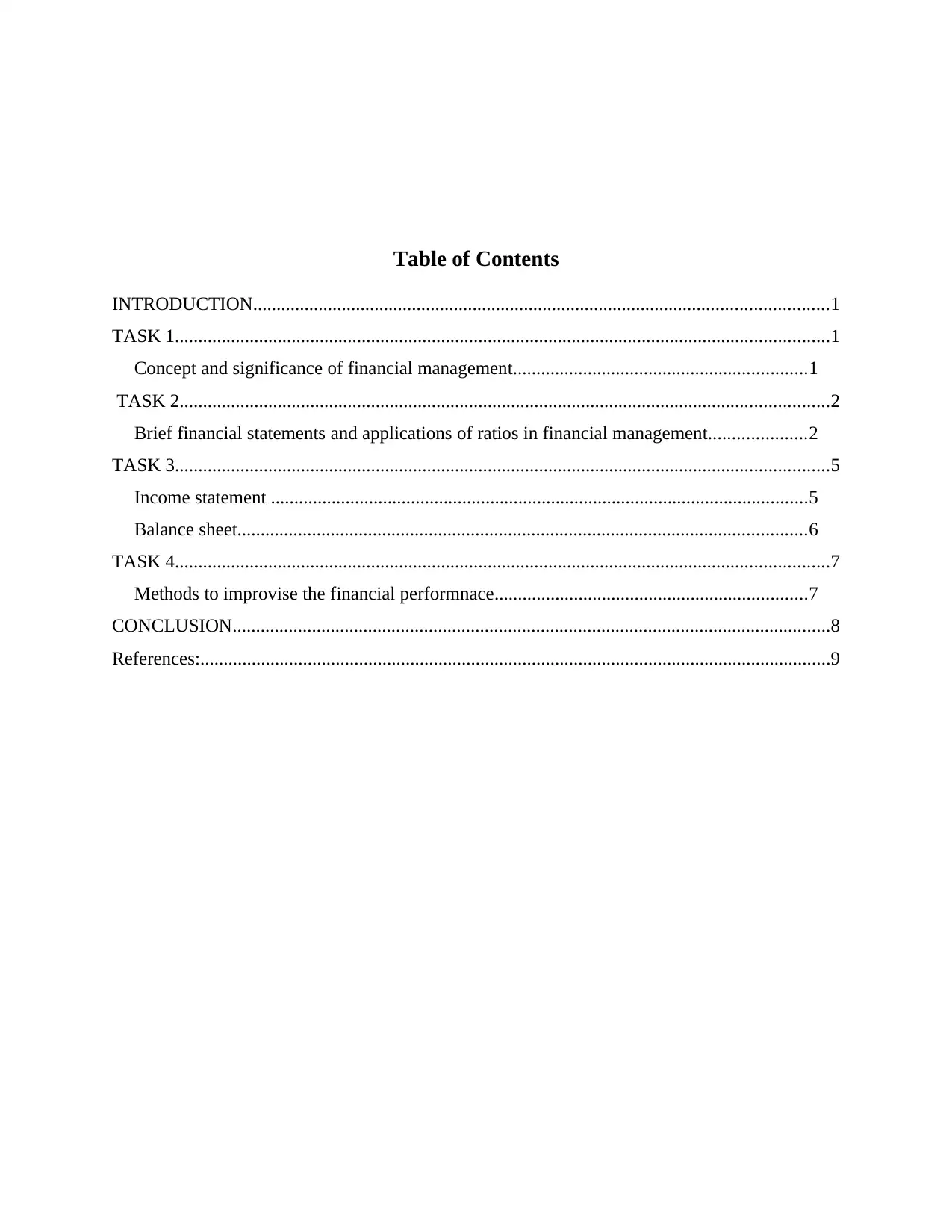
Table of Contents
INTRODUCTION...........................................................................................................................1
TASK 1............................................................................................................................................1
Concept and significance of financial management...............................................................1
TASK 2...........................................................................................................................................2
Brief financial statements and applications of ratios in financial management.....................2
TASK 3............................................................................................................................................5
Income statement ...................................................................................................................5
Balance sheet..........................................................................................................................6
TASK 4............................................................................................................................................7
Methods to improvise the financial performnace...................................................................7
CONCLUSION................................................................................................................................8
References:.......................................................................................................................................9
INTRODUCTION...........................................................................................................................1
TASK 1............................................................................................................................................1
Concept and significance of financial management...............................................................1
TASK 2...........................................................................................................................................2
Brief financial statements and applications of ratios in financial management.....................2
TASK 3............................................................................................................................................5
Income statement ...................................................................................................................5
Balance sheet..........................................................................................................................6
TASK 4............................................................................................................................................7
Methods to improvise the financial performnace...................................................................7
CONCLUSION................................................................................................................................8
References:.......................................................................................................................................9
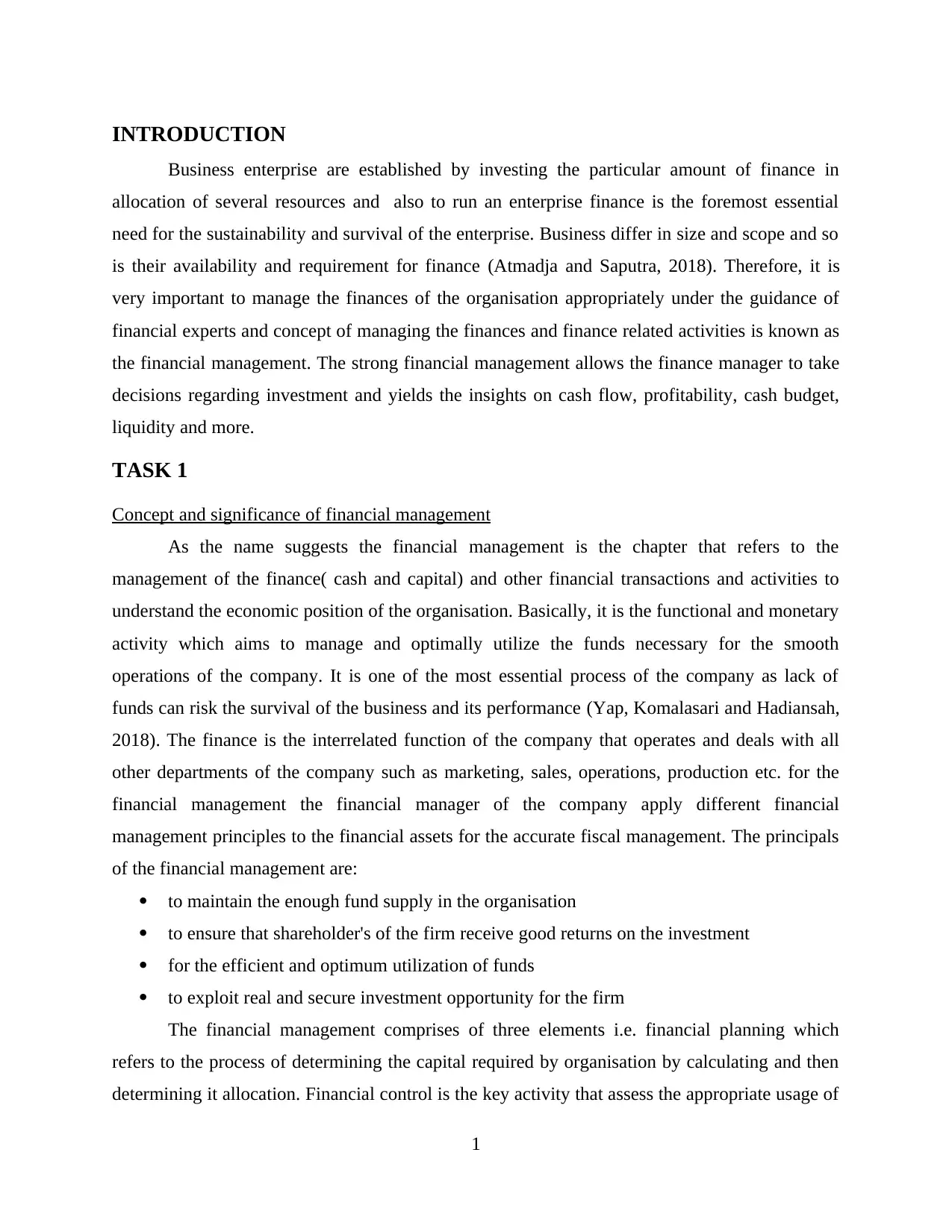
INTRODUCTION
Business enterprise are established by investing the particular amount of finance in
allocation of several resources and also to run an enterprise finance is the foremost essential
need for the sustainability and survival of the enterprise. Business differ in size and scope and so
is their availability and requirement for finance (Atmadja and Saputra, 2018). Therefore, it is
very important to manage the finances of the organisation appropriately under the guidance of
financial experts and concept of managing the finances and finance related activities is known as
the financial management. The strong financial management allows the finance manager to take
decisions regarding investment and yields the insights on cash flow, profitability, cash budget,
liquidity and more.
TASK 1
Concept and significance of financial management
As the name suggests the financial management is the chapter that refers to the
management of the finance( cash and capital) and other financial transactions and activities to
understand the economic position of the organisation. Basically, it is the functional and monetary
activity which aims to manage and optimally utilize the funds necessary for the smooth
operations of the company. It is one of the most essential process of the company as lack of
funds can risk the survival of the business and its performance (Yap, Komalasari and Hadiansah,
2018). The finance is the interrelated function of the company that operates and deals with all
other departments of the company such as marketing, sales, operations, production etc. for the
financial management the financial manager of the company apply different financial
management principles to the financial assets for the accurate fiscal management. The principals
of the financial management are:
to maintain the enough fund supply in the organisation
to ensure that shareholder's of the firm receive good returns on the investment
for the efficient and optimum utilization of funds
to exploit real and secure investment opportunity for the firm
The financial management comprises of three elements i.e. financial planning which
refers to the process of determining the capital required by organisation by calculating and then
determining it allocation. Financial control is the key activity that assess the appropriate usage of
1
Business enterprise are established by investing the particular amount of finance in
allocation of several resources and also to run an enterprise finance is the foremost essential
need for the sustainability and survival of the enterprise. Business differ in size and scope and so
is their availability and requirement for finance (Atmadja and Saputra, 2018). Therefore, it is
very important to manage the finances of the organisation appropriately under the guidance of
financial experts and concept of managing the finances and finance related activities is known as
the financial management. The strong financial management allows the finance manager to take
decisions regarding investment and yields the insights on cash flow, profitability, cash budget,
liquidity and more.
TASK 1
Concept and significance of financial management
As the name suggests the financial management is the chapter that refers to the
management of the finance( cash and capital) and other financial transactions and activities to
understand the economic position of the organisation. Basically, it is the functional and monetary
activity which aims to manage and optimally utilize the funds necessary for the smooth
operations of the company. It is one of the most essential process of the company as lack of
funds can risk the survival of the business and its performance (Yap, Komalasari and Hadiansah,
2018). The finance is the interrelated function of the company that operates and deals with all
other departments of the company such as marketing, sales, operations, production etc. for the
financial management the financial manager of the company apply different financial
management principles to the financial assets for the accurate fiscal management. The principals
of the financial management are:
to maintain the enough fund supply in the organisation
to ensure that shareholder's of the firm receive good returns on the investment
for the efficient and optimum utilization of funds
to exploit real and secure investment opportunity for the firm
The financial management comprises of three elements i.e. financial planning which
refers to the process of determining the capital required by organisation by calculating and then
determining it allocation. Financial control is the key activity that assess the appropriate usage of
1
⊘ This is a preview!⊘
Do you want full access?
Subscribe today to unlock all pages.

Trusted by 1+ million students worldwide
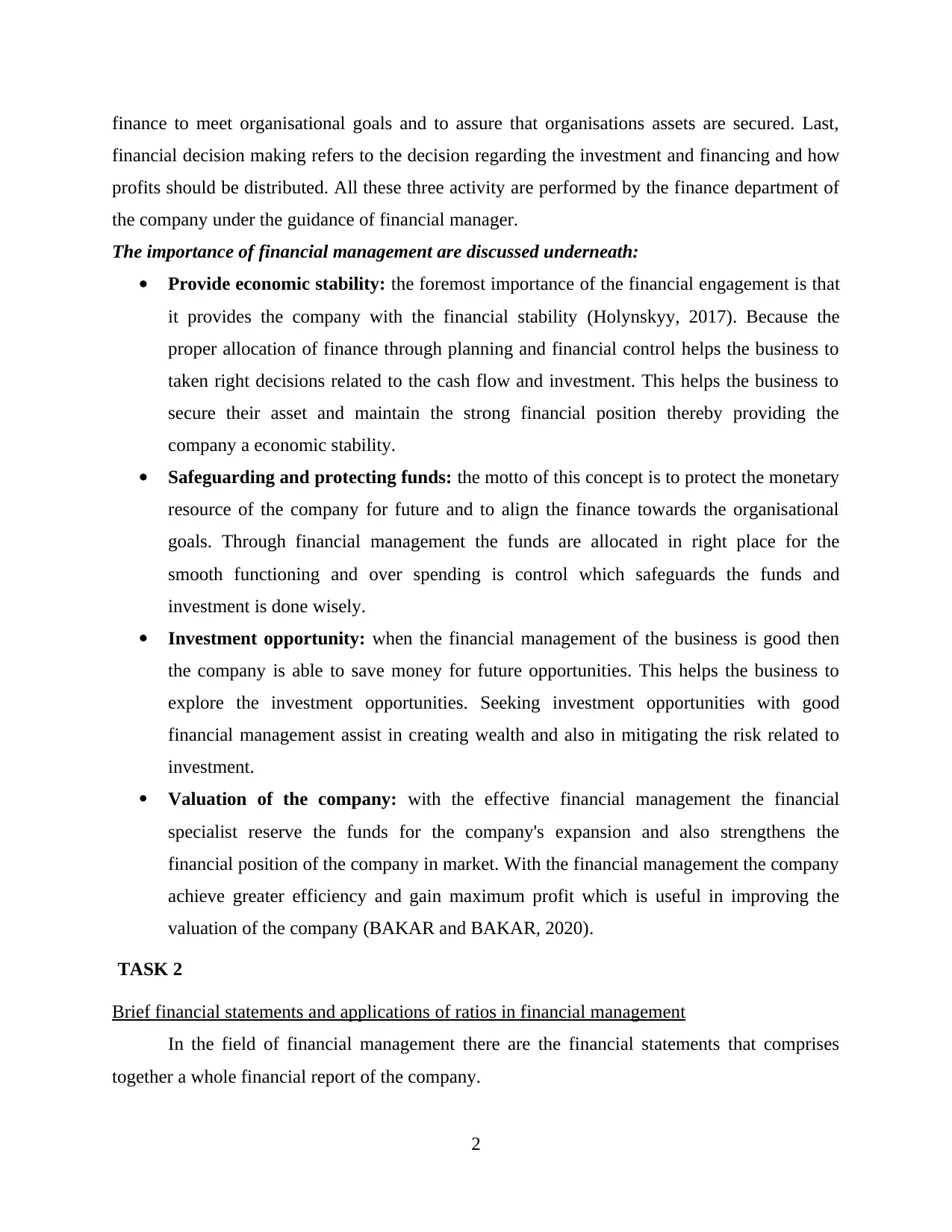
finance to meet organisational goals and to assure that organisations assets are secured. Last,
financial decision making refers to the decision regarding the investment and financing and how
profits should be distributed. All these three activity are performed by the finance department of
the company under the guidance of financial manager.
The importance of financial management are discussed underneath:
Provide economic stability: the foremost importance of the financial engagement is that
it provides the company with the financial stability (Holynskyy, 2017). Because the
proper allocation of finance through planning and financial control helps the business to
taken right decisions related to the cash flow and investment. This helps the business to
secure their asset and maintain the strong financial position thereby providing the
company a economic stability.
Safeguarding and protecting funds: the motto of this concept is to protect the monetary
resource of the company for future and to align the finance towards the organisational
goals. Through financial management the funds are allocated in right place for the
smooth functioning and over spending is control which safeguards the funds and
investment is done wisely.
Investment opportunity: when the financial management of the business is good then
the company is able to save money for future opportunities. This helps the business to
explore the investment opportunities. Seeking investment opportunities with good
financial management assist in creating wealth and also in mitigating the risk related to
investment.
Valuation of the company: with the effective financial management the financial
specialist reserve the funds for the company's expansion and also strengthens the
financial position of the company in market. With the financial management the company
achieve greater efficiency and gain maximum profit which is useful in improving the
valuation of the company (BAKAR and BAKAR, 2020).
TASK 2
Brief financial statements and applications of ratios in financial management
In the field of financial management there are the financial statements that comprises
together a whole financial report of the company.
2
financial decision making refers to the decision regarding the investment and financing and how
profits should be distributed. All these three activity are performed by the finance department of
the company under the guidance of financial manager.
The importance of financial management are discussed underneath:
Provide economic stability: the foremost importance of the financial engagement is that
it provides the company with the financial stability (Holynskyy, 2017). Because the
proper allocation of finance through planning and financial control helps the business to
taken right decisions related to the cash flow and investment. This helps the business to
secure their asset and maintain the strong financial position thereby providing the
company a economic stability.
Safeguarding and protecting funds: the motto of this concept is to protect the monetary
resource of the company for future and to align the finance towards the organisational
goals. Through financial management the funds are allocated in right place for the
smooth functioning and over spending is control which safeguards the funds and
investment is done wisely.
Investment opportunity: when the financial management of the business is good then
the company is able to save money for future opportunities. This helps the business to
explore the investment opportunities. Seeking investment opportunities with good
financial management assist in creating wealth and also in mitigating the risk related to
investment.
Valuation of the company: with the effective financial management the financial
specialist reserve the funds for the company's expansion and also strengthens the
financial position of the company in market. With the financial management the company
achieve greater efficiency and gain maximum profit which is useful in improving the
valuation of the company (BAKAR and BAKAR, 2020).
TASK 2
Brief financial statements and applications of ratios in financial management
In the field of financial management there are the financial statements that comprises
together a whole financial report of the company.
2
Paraphrase This Document
Need a fresh take? Get an instant paraphrase of this document with our AI Paraphraser
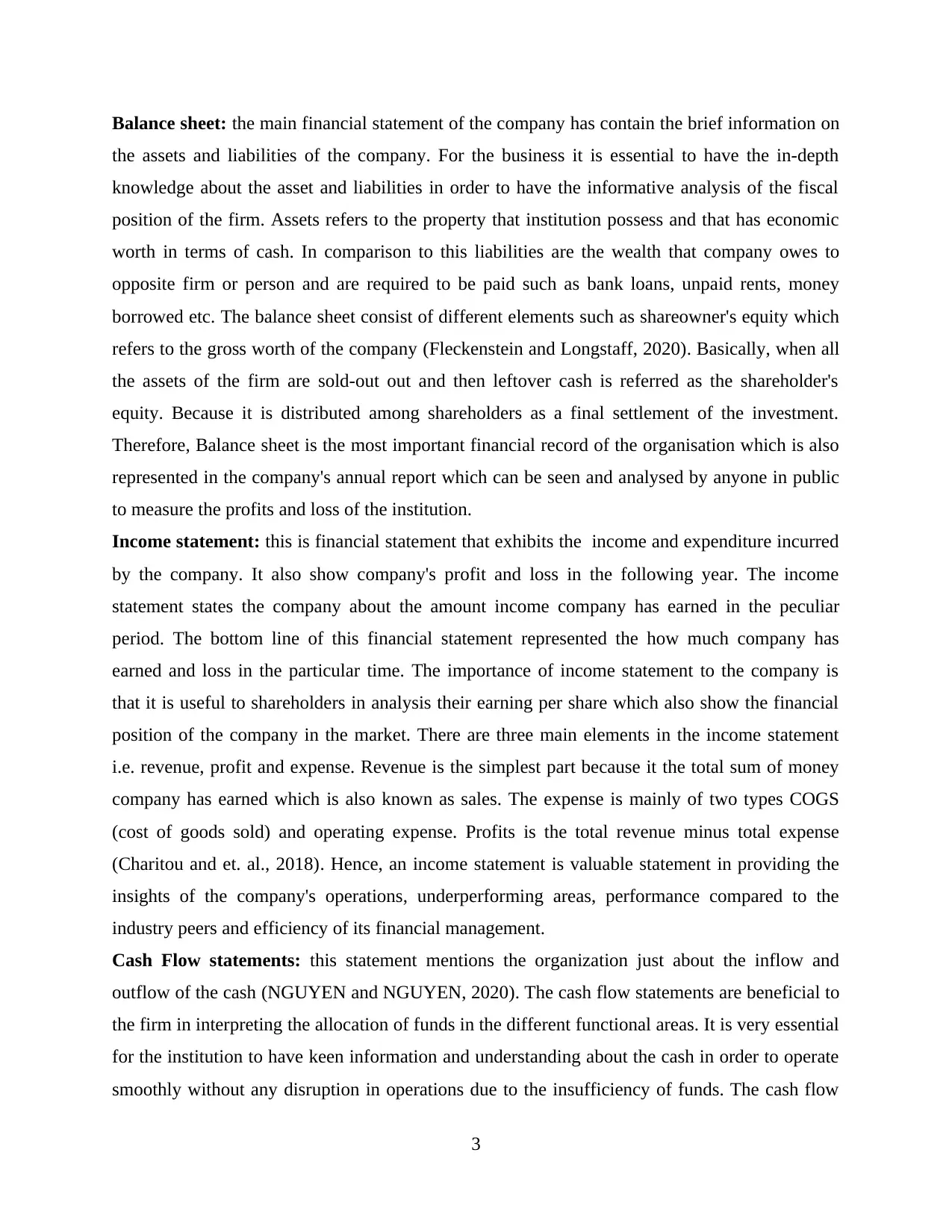
Balance sheet: the main financial statement of the company has contain the brief information on
the assets and liabilities of the company. For the business it is essential to have the in-depth
knowledge about the asset and liabilities in order to have the informative analysis of the fiscal
position of the firm. Assets refers to the property that institution possess and that has economic
worth in terms of cash. In comparison to this liabilities are the wealth that company owes to
opposite firm or person and are required to be paid such as bank loans, unpaid rents, money
borrowed etc. The balance sheet consist of different elements such as shareowner's equity which
refers to the gross worth of the company (Fleckenstein and Longstaff, 2020). Basically, when all
the assets of the firm are sold-out out and then leftover cash is referred as the shareholder's
equity. Because it is distributed among shareholders as a final settlement of the investment.
Therefore, Balance sheet is the most important financial record of the organisation which is also
represented in the company's annual report which can be seen and analysed by anyone in public
to measure the profits and loss of the institution.
Income statement: this is financial statement that exhibits the income and expenditure incurred
by the company. It also show company's profit and loss in the following year. The income
statement states the company about the amount income company has earned in the peculiar
period. The bottom line of this financial statement represented the how much company has
earned and loss in the particular time. The importance of income statement to the company is
that it is useful to shareholders in analysis their earning per share which also show the financial
position of the company in the market. There are three main elements in the income statement
i.e. revenue, profit and expense. Revenue is the simplest part because it the total sum of money
company has earned which is also known as sales. The expense is mainly of two types COGS
(cost of goods sold) and operating expense. Profits is the total revenue minus total expense
(Charitou and et. al., 2018). Hence, an income statement is valuable statement in providing the
insights of the company's operations, underperforming areas, performance compared to the
industry peers and efficiency of its financial management.
Cash Flow statements: this statement mentions the organization just about the inflow and
outflow of the cash (NGUYEN and NGUYEN, 2020). The cash flow statements are beneficial to
the firm in interpreting the allocation of funds in the different functional areas. It is very essential
for the institution to have keen information and understanding about the cash in order to operate
smoothly without any disruption in operations due to the insufficiency of funds. The cash flow
3
the assets and liabilities of the company. For the business it is essential to have the in-depth
knowledge about the asset and liabilities in order to have the informative analysis of the fiscal
position of the firm. Assets refers to the property that institution possess and that has economic
worth in terms of cash. In comparison to this liabilities are the wealth that company owes to
opposite firm or person and are required to be paid such as bank loans, unpaid rents, money
borrowed etc. The balance sheet consist of different elements such as shareowner's equity which
refers to the gross worth of the company (Fleckenstein and Longstaff, 2020). Basically, when all
the assets of the firm are sold-out out and then leftover cash is referred as the shareholder's
equity. Because it is distributed among shareholders as a final settlement of the investment.
Therefore, Balance sheet is the most important financial record of the organisation which is also
represented in the company's annual report which can be seen and analysed by anyone in public
to measure the profits and loss of the institution.
Income statement: this is financial statement that exhibits the income and expenditure incurred
by the company. It also show company's profit and loss in the following year. The income
statement states the company about the amount income company has earned in the peculiar
period. The bottom line of this financial statement represented the how much company has
earned and loss in the particular time. The importance of income statement to the company is
that it is useful to shareholders in analysis their earning per share which also show the financial
position of the company in the market. There are three main elements in the income statement
i.e. revenue, profit and expense. Revenue is the simplest part because it the total sum of money
company has earned which is also known as sales. The expense is mainly of two types COGS
(cost of goods sold) and operating expense. Profits is the total revenue minus total expense
(Charitou and et. al., 2018). Hence, an income statement is valuable statement in providing the
insights of the company's operations, underperforming areas, performance compared to the
industry peers and efficiency of its financial management.
Cash Flow statements: this statement mentions the organization just about the inflow and
outflow of the cash (NGUYEN and NGUYEN, 2020). The cash flow statements are beneficial to
the firm in interpreting the allocation of funds in the different functional areas. It is very essential
for the institution to have keen information and understanding about the cash in order to operate
smoothly without any disruption in operations due to the insufficiency of funds. The cash flow
3
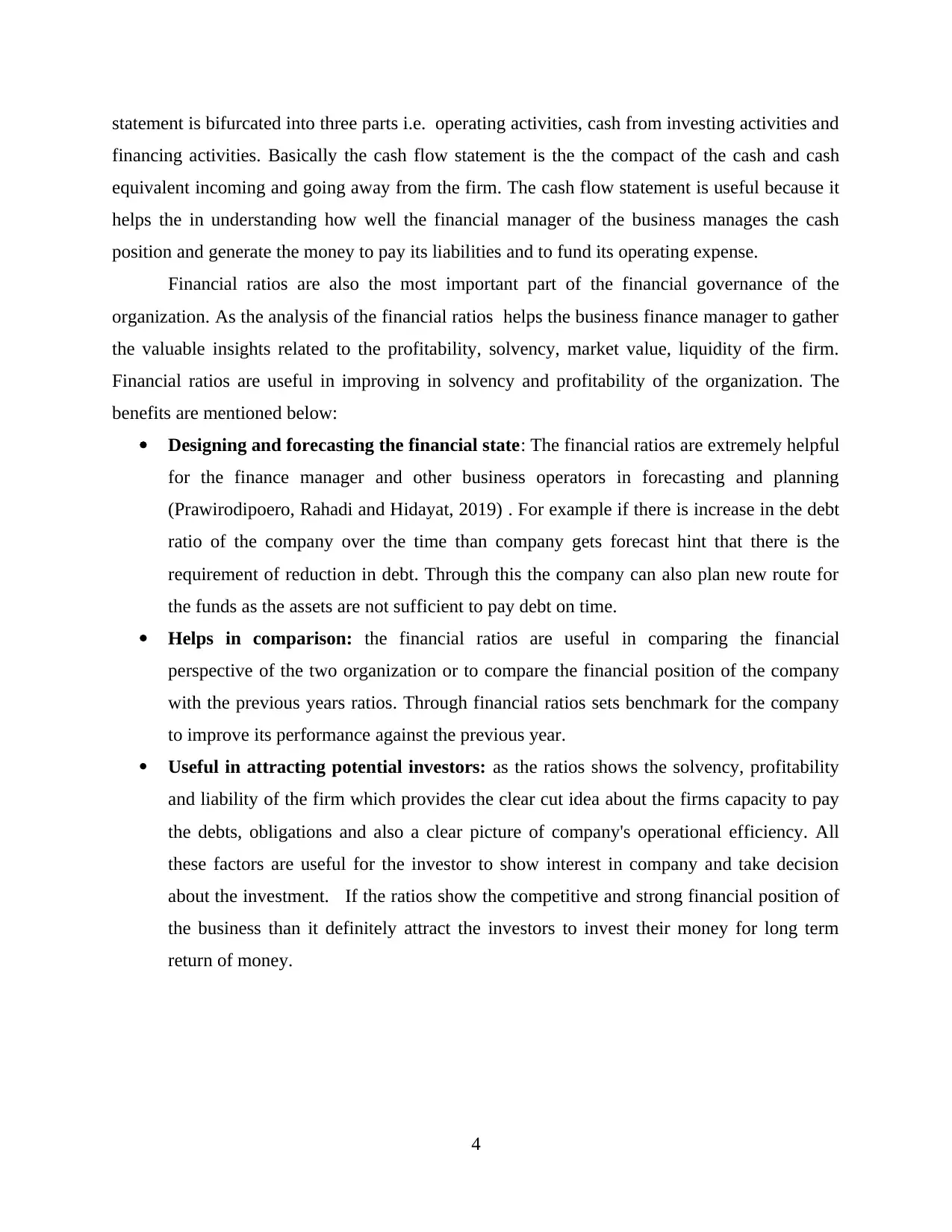
statement is bifurcated into three parts i.e. operating activities, cash from investing activities and
financing activities. Basically the cash flow statement is the the compact of the cash and cash
equivalent incoming and going away from the firm. The cash flow statement is useful because it
helps the in understanding how well the financial manager of the business manages the cash
position and generate the money to pay its liabilities and to fund its operating expense.
Financial ratios are also the most important part of the financial governance of the
organization. As the analysis of the financial ratios helps the business finance manager to gather
the valuable insights related to the profitability, solvency, market value, liquidity of the firm.
Financial ratios are useful in improving in solvency and profitability of the organization. The
benefits are mentioned below:
Designing and forecasting the financial state: The financial ratios are extremely helpful
for the finance manager and other business operators in forecasting and planning
(Prawirodipoero, Rahadi and Hidayat, 2019) . For example if there is increase in the debt
ratio of the company over the time than company gets forecast hint that there is the
requirement of reduction in debt. Through this the company can also plan new route for
the funds as the assets are not sufficient to pay debt on time.
Helps in comparison: the financial ratios are useful in comparing the financial
perspective of the two organization or to compare the financial position of the company
with the previous years ratios. Through financial ratios sets benchmark for the company
to improve its performance against the previous year.
Useful in attracting potential investors: as the ratios shows the solvency, profitability
and liability of the firm which provides the clear cut idea about the firms capacity to pay
the debts, obligations and also a clear picture of company's operational efficiency. All
these factors are useful for the investor to show interest in company and take decision
about the investment. If the ratios show the competitive and strong financial position of
the business than it definitely attract the investors to invest their money for long term
return of money.
4
financing activities. Basically the cash flow statement is the the compact of the cash and cash
equivalent incoming and going away from the firm. The cash flow statement is useful because it
helps the in understanding how well the financial manager of the business manages the cash
position and generate the money to pay its liabilities and to fund its operating expense.
Financial ratios are also the most important part of the financial governance of the
organization. As the analysis of the financial ratios helps the business finance manager to gather
the valuable insights related to the profitability, solvency, market value, liquidity of the firm.
Financial ratios are useful in improving in solvency and profitability of the organization. The
benefits are mentioned below:
Designing and forecasting the financial state: The financial ratios are extremely helpful
for the finance manager and other business operators in forecasting and planning
(Prawirodipoero, Rahadi and Hidayat, 2019) . For example if there is increase in the debt
ratio of the company over the time than company gets forecast hint that there is the
requirement of reduction in debt. Through this the company can also plan new route for
the funds as the assets are not sufficient to pay debt on time.
Helps in comparison: the financial ratios are useful in comparing the financial
perspective of the two organization or to compare the financial position of the company
with the previous years ratios. Through financial ratios sets benchmark for the company
to improve its performance against the previous year.
Useful in attracting potential investors: as the ratios shows the solvency, profitability
and liability of the firm which provides the clear cut idea about the firms capacity to pay
the debts, obligations and also a clear picture of company's operational efficiency. All
these factors are useful for the investor to show interest in company and take decision
about the investment. If the ratios show the competitive and strong financial position of
the business than it definitely attract the investors to invest their money for long term
return of money.
4
⊘ This is a preview!⊘
Do you want full access?
Subscribe today to unlock all pages.

Trusted by 1+ million students worldwide
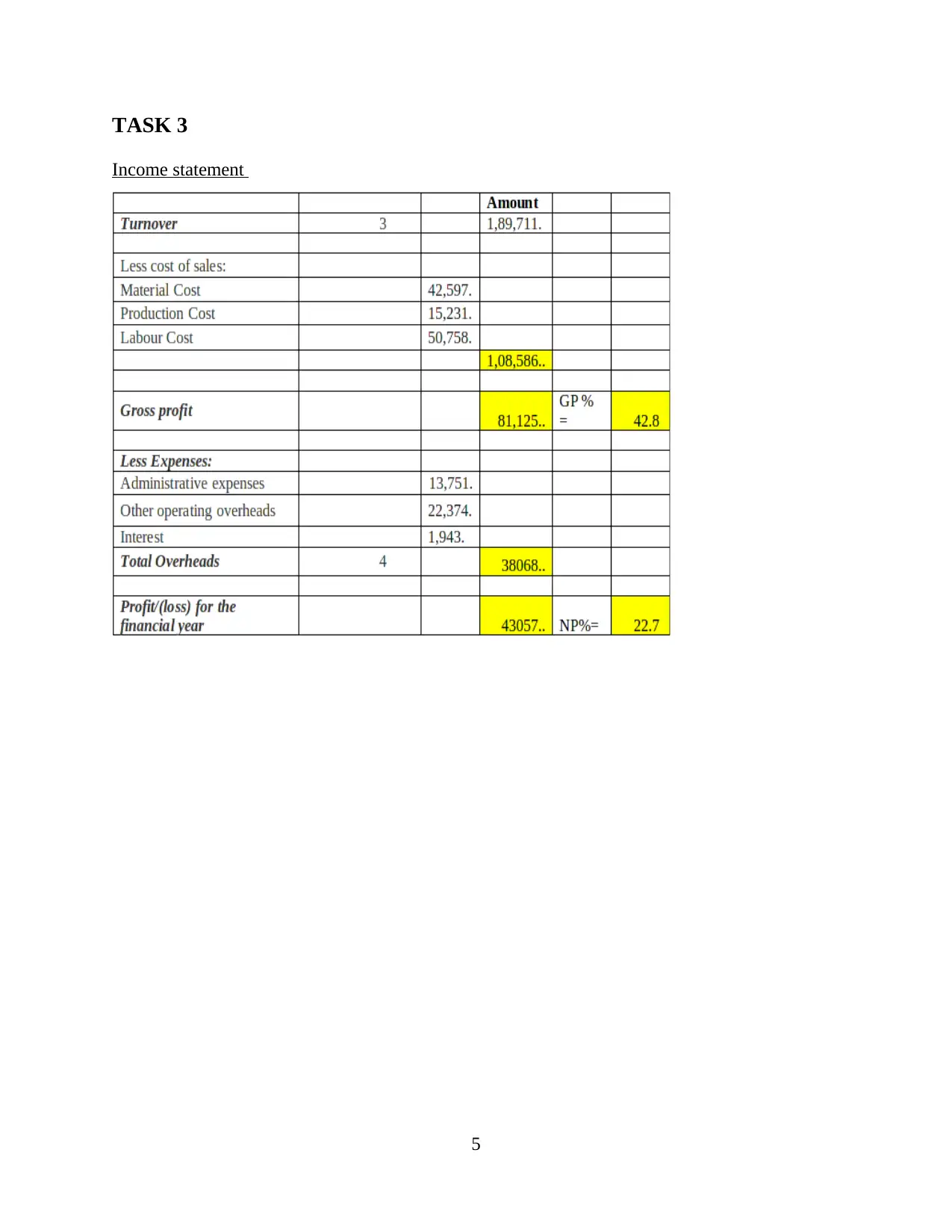
TASK 3
Income statement
5
Income statement
5
Paraphrase This Document
Need a fresh take? Get an instant paraphrase of this document with our AI Paraphraser
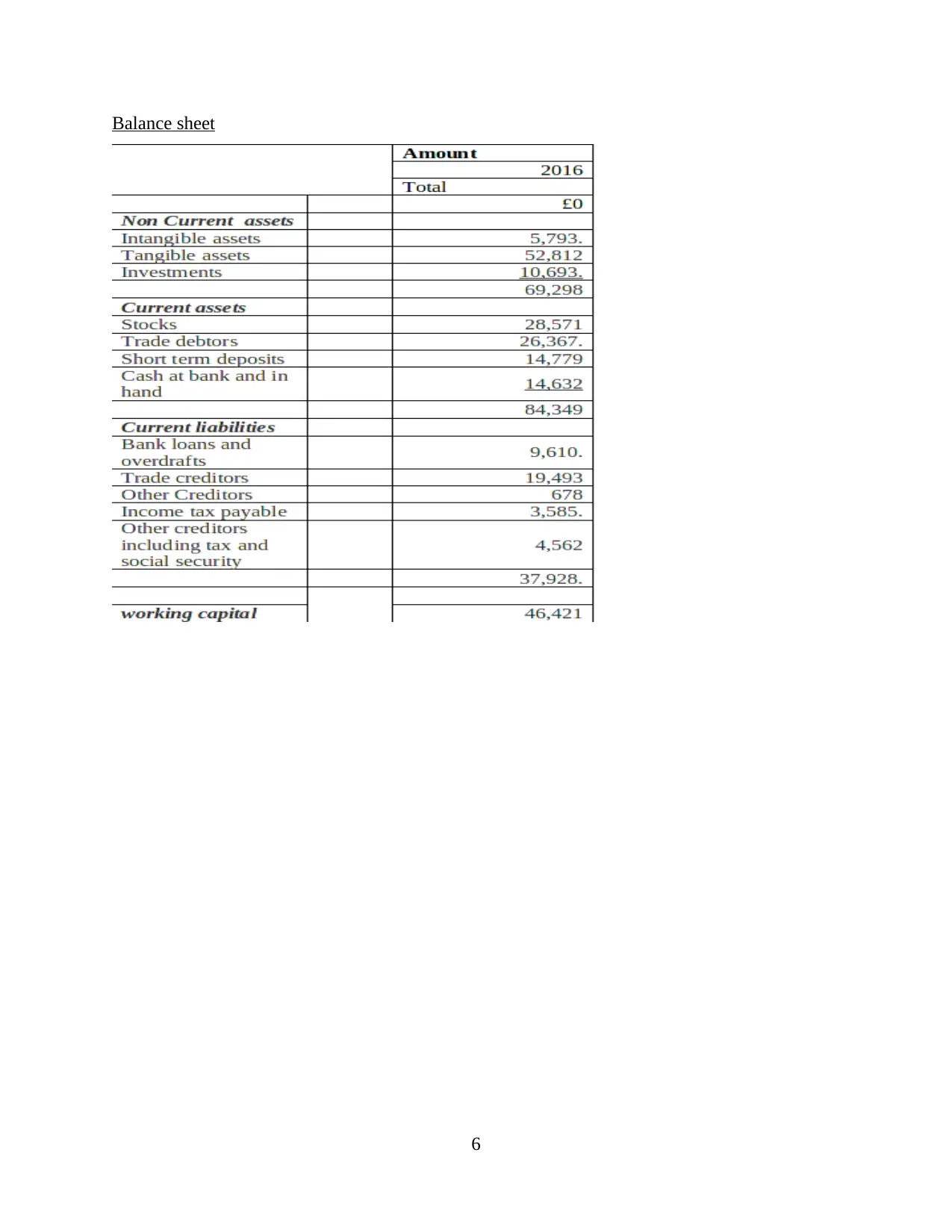
Balance sheet
6
6
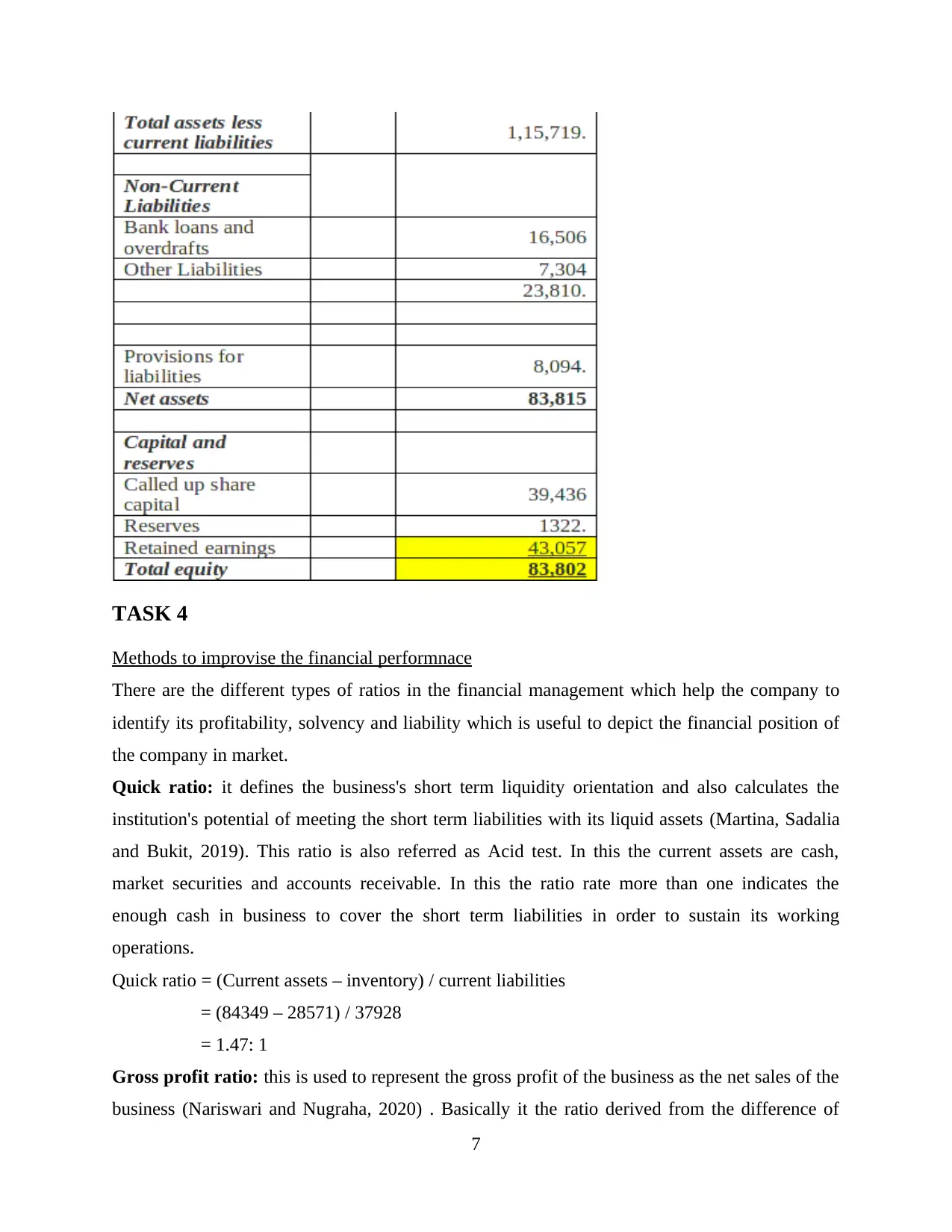
TASK 4
Methods to improvise the financial performnace
There are the different types of ratios in the financial management which help the company to
identify its profitability, solvency and liability which is useful to depict the financial position of
the company in market.
Quick ratio: it defines the business's short term liquidity orientation and also calculates the
institution's potential of meeting the short term liabilities with its liquid assets (Martina, Sadalia
and Bukit, 2019). This ratio is also referred as Acid test. In this the current assets are cash,
market securities and accounts receivable. In this the ratio rate more than one indicates the
enough cash in business to cover the short term liabilities in order to sustain its working
operations.
Quick ratio = (Current assets – inventory) / current liabilities
= (84349 – 28571) / 37928
= 1.47: 1
Gross profit ratio: this is used to represent the gross profit of the business as the net sales of the
business (Nariswari and Nugraha, 2020) . Basically it the ratio derived from the difference of
7
Methods to improvise the financial performnace
There are the different types of ratios in the financial management which help the company to
identify its profitability, solvency and liability which is useful to depict the financial position of
the company in market.
Quick ratio: it defines the business's short term liquidity orientation and also calculates the
institution's potential of meeting the short term liabilities with its liquid assets (Martina, Sadalia
and Bukit, 2019). This ratio is also referred as Acid test. In this the current assets are cash,
market securities and accounts receivable. In this the ratio rate more than one indicates the
enough cash in business to cover the short term liabilities in order to sustain its working
operations.
Quick ratio = (Current assets – inventory) / current liabilities
= (84349 – 28571) / 37928
= 1.47: 1
Gross profit ratio: this is used to represent the gross profit of the business as the net sales of the
business (Nariswari and Nugraha, 2020) . Basically it the ratio derived from the difference of
7
⊘ This is a preview!⊘
Do you want full access?
Subscribe today to unlock all pages.

Trusted by 1+ million students worldwide
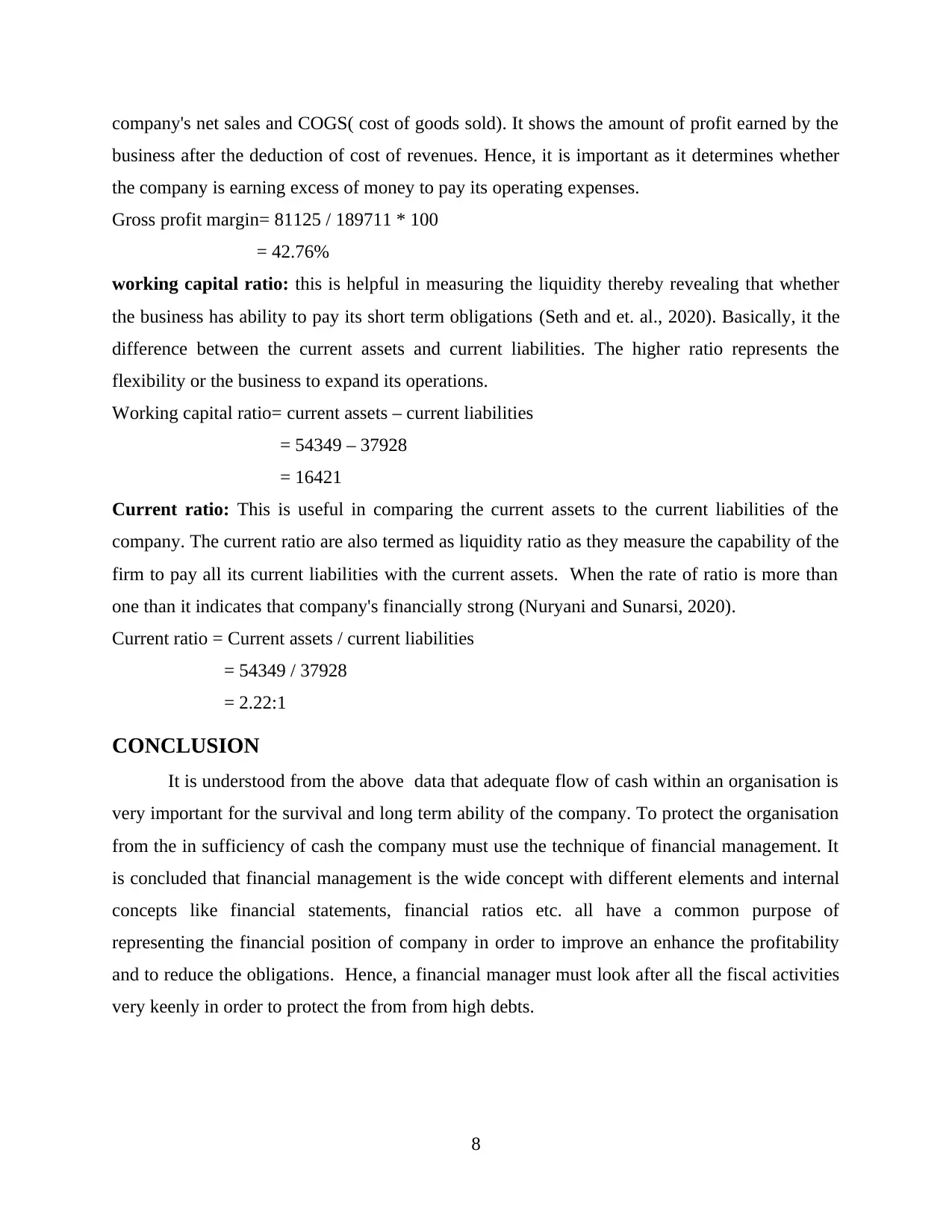
company's net sales and COGS( cost of goods sold). It shows the amount of profit earned by the
business after the deduction of cost of revenues. Hence, it is important as it determines whether
the company is earning excess of money to pay its operating expenses.
Gross profit margin= 81125 / 189711 * 100
= 42.76%
working capital ratio: this is helpful in measuring the liquidity thereby revealing that whether
the business has ability to pay its short term obligations (Seth and et. al., 2020). Basically, it the
difference between the current assets and current liabilities. The higher ratio represents the
flexibility or the business to expand its operations.
Working capital ratio= current assets – current liabilities
= 54349 – 37928
= 16421
Current ratio: This is useful in comparing the current assets to the current liabilities of the
company. The current ratio are also termed as liquidity ratio as they measure the capability of the
firm to pay all its current liabilities with the current assets. When the rate of ratio is more than
one than it indicates that company's financially strong (Nuryani and Sunarsi, 2020).
Current ratio = Current assets / current liabilities
= 54349 / 37928
= 2.22:1
CONCLUSION
It is understood from the above data that adequate flow of cash within an organisation is
very important for the survival and long term ability of the company. To protect the organisation
from the in sufficiency of cash the company must use the technique of financial management. It
is concluded that financial management is the wide concept with different elements and internal
concepts like financial statements, financial ratios etc. all have a common purpose of
representing the financial position of company in order to improve an enhance the profitability
and to reduce the obligations. Hence, a financial manager must look after all the fiscal activities
very keenly in order to protect the from from high debts.
8
business after the deduction of cost of revenues. Hence, it is important as it determines whether
the company is earning excess of money to pay its operating expenses.
Gross profit margin= 81125 / 189711 * 100
= 42.76%
working capital ratio: this is helpful in measuring the liquidity thereby revealing that whether
the business has ability to pay its short term obligations (Seth and et. al., 2020). Basically, it the
difference between the current assets and current liabilities. The higher ratio represents the
flexibility or the business to expand its operations.
Working capital ratio= current assets – current liabilities
= 54349 – 37928
= 16421
Current ratio: This is useful in comparing the current assets to the current liabilities of the
company. The current ratio are also termed as liquidity ratio as they measure the capability of the
firm to pay all its current liabilities with the current assets. When the rate of ratio is more than
one than it indicates that company's financially strong (Nuryani and Sunarsi, 2020).
Current ratio = Current assets / current liabilities
= 54349 / 37928
= 2.22:1
CONCLUSION
It is understood from the above data that adequate flow of cash within an organisation is
very important for the survival and long term ability of the company. To protect the organisation
from the in sufficiency of cash the company must use the technique of financial management. It
is concluded that financial management is the wide concept with different elements and internal
concepts like financial statements, financial ratios etc. all have a common purpose of
representing the financial position of company in order to improve an enhance the profitability
and to reduce the obligations. Hence, a financial manager must look after all the fiscal activities
very keenly in order to protect the from from high debts.
8
Paraphrase This Document
Need a fresh take? Get an instant paraphrase of this document with our AI Paraphraser
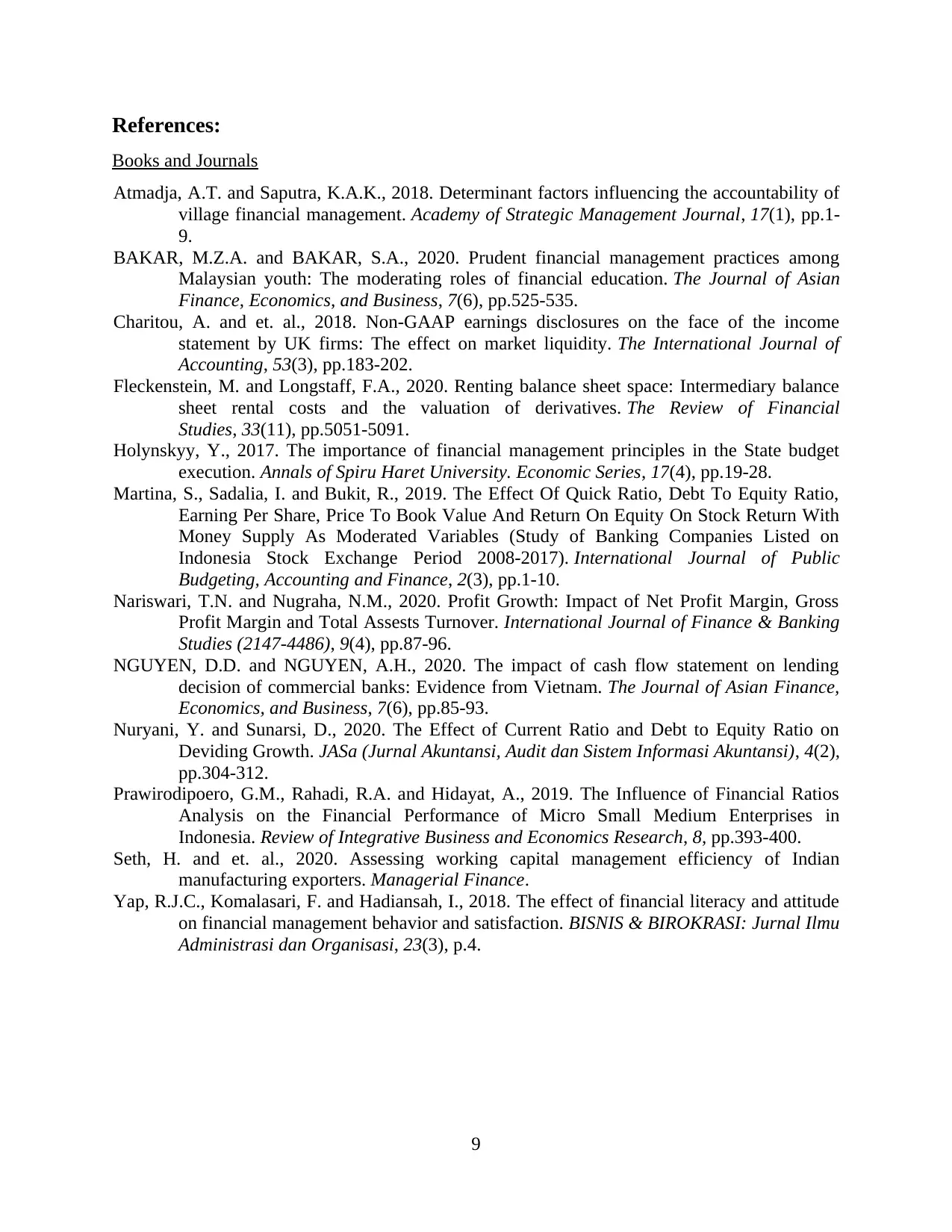
References:
Books and Journals
Atmadja, A.T. and Saputra, K.A.K., 2018. Determinant factors influencing the accountability of
village financial management. Academy of Strategic Management Journal, 17(1), pp.1-
9.
BAKAR, M.Z.A. and BAKAR, S.A., 2020. Prudent financial management practices among
Malaysian youth: The moderating roles of financial education. The Journal of Asian
Finance, Economics, and Business, 7(6), pp.525-535.
Charitou, A. and et. al., 2018. Non-GAAP earnings disclosures on the face of the income
statement by UK firms: The effect on market liquidity. The International Journal of
Accounting, 53(3), pp.183-202.
Fleckenstein, M. and Longstaff, F.A., 2020. Renting balance sheet space: Intermediary balance
sheet rental costs and the valuation of derivatives. The Review of Financial
Studies, 33(11), pp.5051-5091.
Holynskyy, Y., 2017. The importance of financial management principles in the State budget
execution. Annals of Spiru Haret University. Economic Series, 17(4), pp.19-28.
Martina, S., Sadalia, I. and Bukit, R., 2019. The Effect Of Quick Ratio, Debt To Equity Ratio,
Earning Per Share, Price To Book Value And Return On Equity On Stock Return With
Money Supply As Moderated Variables (Study of Banking Companies Listed on
Indonesia Stock Exchange Period 2008-2017). International Journal of Public
Budgeting, Accounting and Finance, 2(3), pp.1-10.
Nariswari, T.N. and Nugraha, N.M., 2020. Profit Growth: Impact of Net Profit Margin, Gross
Profit Margin and Total Assests Turnover. International Journal of Finance & Banking
Studies (2147-4486), 9(4), pp.87-96.
NGUYEN, D.D. and NGUYEN, A.H., 2020. The impact of cash flow statement on lending
decision of commercial banks: Evidence from Vietnam. The Journal of Asian Finance,
Economics, and Business, 7(6), pp.85-93.
Nuryani, Y. and Sunarsi, D., 2020. The Effect of Current Ratio and Debt to Equity Ratio on
Deviding Growth. JASa (Jurnal Akuntansi, Audit dan Sistem Informasi Akuntansi), 4(2),
pp.304-312.
Prawirodipoero, G.M., Rahadi, R.A. and Hidayat, A., 2019. The Influence of Financial Ratios
Analysis on the Financial Performance of Micro Small Medium Enterprises in
Indonesia. Review of Integrative Business and Economics Research, 8, pp.393-400.
Seth, H. and et. al., 2020. Assessing working capital management efficiency of Indian
manufacturing exporters. Managerial Finance.
Yap, R.J.C., Komalasari, F. and Hadiansah, I., 2018. The effect of financial literacy and attitude
on financial management behavior and satisfaction. BISNIS & BIROKRASI: Jurnal Ilmu
Administrasi dan Organisasi, 23(3), p.4.
9
Books and Journals
Atmadja, A.T. and Saputra, K.A.K., 2018. Determinant factors influencing the accountability of
village financial management. Academy of Strategic Management Journal, 17(1), pp.1-
9.
BAKAR, M.Z.A. and BAKAR, S.A., 2020. Prudent financial management practices among
Malaysian youth: The moderating roles of financial education. The Journal of Asian
Finance, Economics, and Business, 7(6), pp.525-535.
Charitou, A. and et. al., 2018. Non-GAAP earnings disclosures on the face of the income
statement by UK firms: The effect on market liquidity. The International Journal of
Accounting, 53(3), pp.183-202.
Fleckenstein, M. and Longstaff, F.A., 2020. Renting balance sheet space: Intermediary balance
sheet rental costs and the valuation of derivatives. The Review of Financial
Studies, 33(11), pp.5051-5091.
Holynskyy, Y., 2017. The importance of financial management principles in the State budget
execution. Annals of Spiru Haret University. Economic Series, 17(4), pp.19-28.
Martina, S., Sadalia, I. and Bukit, R., 2019. The Effect Of Quick Ratio, Debt To Equity Ratio,
Earning Per Share, Price To Book Value And Return On Equity On Stock Return With
Money Supply As Moderated Variables (Study of Banking Companies Listed on
Indonesia Stock Exchange Period 2008-2017). International Journal of Public
Budgeting, Accounting and Finance, 2(3), pp.1-10.
Nariswari, T.N. and Nugraha, N.M., 2020. Profit Growth: Impact of Net Profit Margin, Gross
Profit Margin and Total Assests Turnover. International Journal of Finance & Banking
Studies (2147-4486), 9(4), pp.87-96.
NGUYEN, D.D. and NGUYEN, A.H., 2020. The impact of cash flow statement on lending
decision of commercial banks: Evidence from Vietnam. The Journal of Asian Finance,
Economics, and Business, 7(6), pp.85-93.
Nuryani, Y. and Sunarsi, D., 2020. The Effect of Current Ratio and Debt to Equity Ratio on
Deviding Growth. JASa (Jurnal Akuntansi, Audit dan Sistem Informasi Akuntansi), 4(2),
pp.304-312.
Prawirodipoero, G.M., Rahadi, R.A. and Hidayat, A., 2019. The Influence of Financial Ratios
Analysis on the Financial Performance of Micro Small Medium Enterprises in
Indonesia. Review of Integrative Business and Economics Research, 8, pp.393-400.
Seth, H. and et. al., 2020. Assessing working capital management efficiency of Indian
manufacturing exporters. Managerial Finance.
Yap, R.J.C., Komalasari, F. and Hadiansah, I., 2018. The effect of financial literacy and attitude
on financial management behavior and satisfaction. BISNIS & BIROKRASI: Jurnal Ilmu
Administrasi dan Organisasi, 23(3), p.4.
9
1 out of 11
Related Documents
Your All-in-One AI-Powered Toolkit for Academic Success.
+13062052269
info@desklib.com
Available 24*7 on WhatsApp / Email
![[object Object]](/_next/static/media/star-bottom.7253800d.svg)
Unlock your academic potential
Copyright © 2020–2025 A2Z Services. All Rights Reserved. Developed and managed by ZUCOL.





